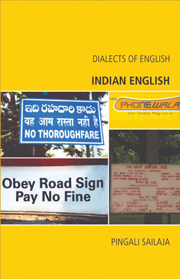Book contents
- Frontmatter
- Contents
- Preface
- Acknowledgements
- Abbreviations, Symbols and other Notational Conventions Used
- 1 Introduction
- 2 Phonetics and Phonology
- 3 Morphosyntax
- 4 Lexis and Discourse
- 5 History and Changes in Progress
- 6 Survey of Previous Work and Annotated Bibliography
- 7 Sample Texts
- Bibliography of Cited Works
- Index
2 - Phonetics and Phonology
Published online by Cambridge University Press: 05 August 2013
- Frontmatter
- Contents
- Preface
- Acknowledgements
- Abbreviations, Symbols and other Notational Conventions Used
- 1 Introduction
- 2 Phonetics and Phonology
- 3 Morphosyntax
- 4 Lexis and Discourse
- 5 History and Changes in Progress
- 6 Survey of Previous Work and Annotated Bibliography
- 7 Sample Texts
- Bibliography of Cited Works
- Index
Summary
Indian English (IE) is best identified through its phonological features yet, paradoxically, the variation in the phonology is widespread. There is a standard variety of IE both in terms of phonology and syntax. It is essential, however, to maintain a distinction between the grammar and accent.
This chapter will deal with the standard accent and touch upon variation as well. Accent in Indian speech is marked by regional variation. Standard accent is usually devoid of regional markers but it is still identifiable as Indian by virtue of some pan-Indian features. There is also an intermediate accent that is more Indian than the standard, as a consequence of the extent to which the regional features appear in it.
Teachers of IE pronunciation have usually imposed an unattainable standard from the purely pedagogical point of view – Received Pronunciation (RP), which is the standard British accent from southern Britain. This has happened in spite of the fact that the British who came to India were from different parts of Britain. There were the Irish and Scots as well in colonial India. Many of the English themselves were not speakers of standard RP. Since English is taught as a second language in India, the issue of a standard for teaching has vexed and continues to vex classrooms. As early as 1800, an advertisement by William Carey from Serampore offering to teach English with particular attention to correct pronunciation appeared (Sinha 1978: 23–4).
- Type
- Chapter
- Information
- Indian English , pp. 17 - 38Publisher: Edinburgh University PressPrint publication year: 2009



